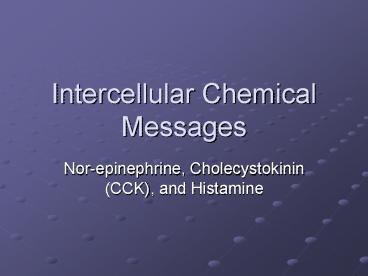Intercellular Chemical Messages - PowerPoint PPT Presentation
1 / 16
Title:
Intercellular Chemical Messages
Description:
Binds to adrenergic receptors on target cells. Hormone Secretion From the Adrenal Medulla ... it is carried to adrenergic receptors on various visceral target ... – PowerPoint PPT presentation
Number of Views:22
Avg rating:3.0/5.0
Title: Intercellular Chemical Messages
1
Intercellular Chemical Messages
- Nor-epinephrine, Cholecystokinin (CCK), and
Histamine
2
Problem/Question
- Nor-epinephrine, CCK, and Histamines have
multiple actions related to various target cell
receptors - Know as a neurotransmitter, GI hormone, and
paracrine, respectively, all have other functions
as well - We will classify them and describe their actions
as well as provide an example of a drug that
either mimics or blocks the effects of the
chemical messages
3
Nor-epinephrine
- Is a neurotransmitter when released by a neuron
into the synapse - Is a hormone when released into the blood by the
Adrenal Medulla - Sends chemical messages to many different target
tissues - Smooth muscle
- Cardiac muscle
- Endocrine and exocrine glands
- Adipose Tissue
4
Neurotransmitter Release in the Synapse
- At synapses in the CNS, nor-epinephrine affects
the part of the brain where impulsivity and
attention are controlled - This also effects the Fight or Flight Response
during stress - Binds to adrenergic receptors on target cells
5
Hormone Secretion From the Adrenal Medulla
- A stressful stimulus causes acetylcholine release
from pre-ganglionic sympathetic fibers
innervating the medulla - This stimulates the release of Nor-epinephrine
into the blood where it is carried to adrenergic
receptors on various visceral target tissues - Nor-epinephrine (NE) secreted as a hormone into
the blood intensifies and prolongs the responses
caused by NE released as a neurotransmitter from
sympathetic postganglionic axons.
6
Alpha (a) Receptors
- At a1 receptors, NE causes smooth muscle
contraction of the arterioles (Vasoconstriction) - During the Fight or Flight response
vasoconstriction helps blood go only where it is
needed (skeletal muscles, liver, and heart) and
diverts it from the GI tract where it is not
needed - At a2 receptors, NE causes the smooth muscle of
the GI tract to relax and decreases pancreatic
secretions
7
Beta (ß) Receptors
- At ß1 receptors, NE causes increased heart rate,
and therefore blood pressure
8
Propranolol ß antagonist
- Drug used for angina pectoris (chest pain) and
cardiac arrhythmias (abnormal heart rate)
hypertension (high blood pressure) - A non-specific ß -Blocker which binds to both
types of ß receptors and prevents their
activation by Nor-epinephrine - The effects of Propranolol are decreased heart
rate and force of contraction which decreases
blood pressure
9
Cholecystokinin (CCK)
- Intestinal hormone
- Secreted by the duodenum, and
- causes the release of digestive
- enzymes and bile form the
- pancreas and gallbladder, respectively
- Help to digest fat, protein and carbohydrate,
aids in their digestion and absorption
10
Cholecystokinin
- Also acts as a neurotransmitter in the brain
- Mediates satiety by acting on the receptors
distributed widely throughout the central nervous
system - Decreases the desire to eat by giving you a
feeling of fullness - CCK administration significantly reduces hunger
in adult male rats
11
Satietrol
- A powder drink mix supplement with
- main ingredient of potatoes also containing the
milk-derived protein glycomacropeptide - Used as a meal replacement, low calorie snack, or
as a drink prior to eating it stimulates the
release of CCK - Shown to speed up the digestive process and
decrease hunger, helping in weight loss
12
What is Histamine?
- Histamine literally means a vasoactive amine
made up of histidine residues - It is a paracrine released by damaged cells that
acts on the cells in its immediate vicinity - It is also a protein involved in allergic
reactions and acts as a neurotransmitter in the
sleep-wake cycle
13
What does it do?
- Inflammatory response
- Directly
- Upon the release of histamine by the mast cell,
the permeability of the nearby vessels increases.
- This leads to the movement of blood fluids into
the area which leads to swelling (edema). - Indirectly
- Histamine can also trigger a response by other
leukocytes in the area which leads to
inflammation.
14
What does it do?
- Allergic response
- A normally harmless substance (i.e. pollen) comes
in contact with lymphocytes (mast cells) specific
for that substance (antigen). - This results in the release of histamine into the
surrounding tissues. - Sleep-Wake Cycle
- Histamine seems to have an arousal effect on
the brain and when histamine is released in the
brain, wakefulness occurs.
15
Drugs that block the messages?
- Antihistamines
- drugs that inhibit the response associated with
histamine - Anti-histamines often have a drowsiness effect
and this can be explained by histamines role in
wakefulness. - Claritin
- Claritin results in the neutralization of
histamine which prevents it from binding and
activating immune-related cells in the area.
16
Analogy































